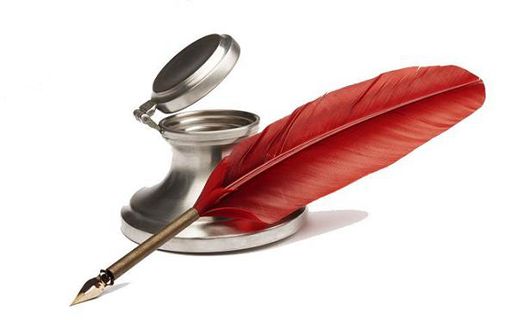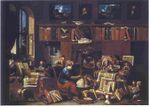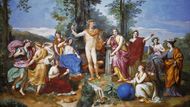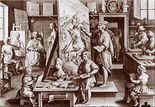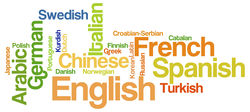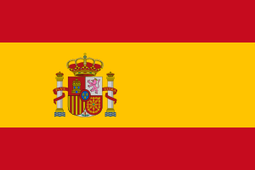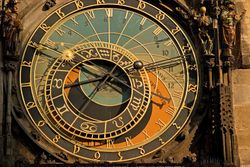Category:Spanish
Jump to navigation
Jump to search
Famous Spaniards
- San Ignacio de Loyola (c.1491-1556) -- Priest. Founder of the Society of Jesus.
- Isabella I of Castile (1451–1504) -- Queen of Castile and León (1474–1504).
- Francisco Pizarro (1476–1541) -- Explorer.
- Teresa of Ávila (1515-1582) -- Mystic, poet, theologian and writer. One of the most popular Catholic saints in Spain. Canonized in 1622.
- El Greco (1541–1614) -- Painter.
- Miguel de Cervantes (1547-1616) -- Novelist. Author of Don Quixote, a literary classic widely considered one of the best novels ever written. It has been translated in countless languages all over the world. Cervantes himself is also hailed as the most important and influential Spanish-language author of all time.
- Felix Lope de Vega (1562–1635) -- Novelist, poet and playwright
- Diego Velázquez (1599–1660) -- Renowned artist of the Golden Age of Art and Literature (circa 1556-1659), hails from Andalucía. His brush brought to life a multitude of historically and culturally significant compositions, including iconic portraits of the Spanish royal family.
- Francisco de Goya (1746–1828) -- Painter and printmaker. Drew significant inspiration from the works of Velázquez. He stands as a highly influential artist spanning the late 18th and early 19th centuries. Goya specialized primarily in portraiture, producing numerous captivating portraits of the Spanish royal family and the aristocracy.
- Antoni Gaudí (1852–1926) -- Architect. His native city of Barcelona boasts several of his renowned works, including Casa Batlló, Casa Milà, and, most notably, La Basílica de la Sagrada Familia. Tragically, Gaudí passed away in 1926 while still engrossed in the construction of La Sagrada Familia, which remains incomplete to this very day.
- Pablo Picasso (1881-1973) -- Painter and sculptor. Creator of works such as Les Demoiselles d'Avignon and Guernica. Widely praised as one of the most important, groundbreaking and influential artists of all time, he played a pioneering role in the avant-garde Cubism movement, but his artistic versatility extended beyond painting to encompass sculpture, poetry, playwriting, printmaking, and ceramics.
- Francisco Franco (1892-1975) -- Franco ascended to power following the Nationalist military rebellion, which toppled Spain’s democratic republic in the wake of the Spanish Civil War. He subsequently ruled Spain as a conservative, monarchist general, and dictator, from 1939 to his death in 1975.
- Federico García Lorca (1898–1936) -- Poet and dramatist, known for his poetic works, including “Impresiones y paisajes” (1918) and “Romancero Gitano” (1928). His poetry delved into themes of love and tragedy, drawing inspiration from Gypsy culture, Flamenco music, and Spanish folklore. Tragically, Federico García Lorca’s life was cut short when he was arrested and executed in 1936 by soldiers loyal to Francisco Franco, due to his political views and his homosexuality.
- Luis Buñuel (1900–1983) -- Film director
- Salvador Dalí (1904–1989) -- The renowned Spanish surrealist artist Salvador Dali, born in Cataluña, unquestionably ranks among the most iconic figures in Spanish history. Dali was a multifaceted creative, engaging in painting, sculpture, writing, filmmaking, and photography. However, he is most celebrated for his imaginative and captivating paintings, exemplified by masterpieces like “The Persistence of Memory.”
- Montserrat Caballé (1933–2018) -- Opera contralto singer.
- Plácido Domingo (1941) -- Opera tenor singer.
- Pedro Almodóvar (1949) -- Film director, screenwriter and producer
- Rafael Nadal (1986) -- A tennis legend with 22 Grand Slam singles titles to his name, ranking second in history. Hailing from Mallorca, Nadal holds the remarkable record of 12 victories at the Roland-Garros French Open.
Subcategories
This category has only the following subcategory.
Pages in category "Spanish"
The following 160 pages are in this category, out of 160 total.
1
- Yehuda Halevi (M / Spain, 1075/85-1141), scholar
- Robert of Ketton (M / Britain, Spain, 1110? – 1160?), scholar
- Mark of Toledo (M / Spain, d.1216), scholar
- Ramon Martí (M / Spain, 1215c-1285c), scholar
- Ramon Llull (M / Spain, 1232c-1315), scholar
- Alonso Tostado (M / Spain, c1400-1455), scholar
- Alfonso de Palencia (M / Spain, 1423-1492), scholar
- Juan de la Abadia
- Solomon ibn Verga (M / Spain, 1450c-1525c), scholar
- Abraham ben Samuel Zacuto (M / Spain, Portugal, Tunisia, 1452-1515), scholar
- Diego López de Zúñiga (M / Spain, 1470c-1531), scholar
- Alonso Berruguete (M / Spain, 1488-1561), artist
- Jacob Tam ibn Yahya
- Juan Martín Cordero (M / Spain, 1520-1584), scholar
- Juan de Juanes (1523-1579), artist
- Benito Arias Montano (1527-1598), scholar
- Antonio del Corro (M / Spain, Britain, 1527-1591), scholar
- Juan Maldonado (M / Spain, France, 1533-1583), scholar
- Francisco de Ribera (M / Spain, 1537-1591), scholar
- José de Acosta (1539-1600), scholar
- Juan Luis de la Cerda (1560-1643), scholar
- Gaspar de Aguilar (M / Spain / 1561-1623), playwright
- Tirso de Molina (M / Spain / 1571?-1648), playwright
- Luis de Urreta (1570-1636), Spanish scholar
- Felipe Godínez (M / Spain / 1585-1659), playwright
- Francisco Herrera the Helder (1590c-1656), artist
- Jusepe de Ribera (1591-1652), artist
- Álvaro Cubillo de Aragón (M / Spain / 1596?-1661), playwright
- Francisco Zurbarán (1598-1664), artist
- Diego Velázquez (1599-1660), artist
- Pedro Calderón de la Barca (M / Spain / 1600-1681), playwright
- Jusepe Martínez (1600-1682), artist
- Joseph Semah Arias (M / Spain, 17th century), scholar
- Alonso Cano (1601-1667), artist
- Maria de Agreda (F / Spain, 1602-1665), visionary
- Cristóbal Lozano (M / Spain, 1609-1667), playwright
- Bartolomé Esteban Murillo (1617-1682), artist
- Juan de Valdés Leal (1622-1690), artist
- Juan Antonio Frías y Escalante (1633-1670), artist
- Antonio de Zamora (M / Spain, 1664-1728), playwright
- Salvador Figuera (M / Spain, 18th cent.), composer
- José Picanyol (M / Spain, 1700c-1757c), composer
- Francisco Goya (1746-1828), artist
- Juan López Peñalver (M / Spain, 1763-1835), scholar
- José Zorrilla y Moral (M / Spain, 1817-1893), playwright
- Francisco Jareño (1818–1892), artist
- Ramón Franquelo (M / Spain, 1824-1874), playwright
- Ricardo Bellver (1845-1924), artist
- Angel Guimerá (M / Spain, 1845-1924), playwright
- Luis Ricardo Falero (1851-1896), artist
- Armando Palacio Valdés (M / Spain, 1853-1938), novelist
- Gregoria Urbina y Miranda
- Enrique Simonet (1866-1927), scholar
- Félix Azzati (M / Spain, 1874-1929), translator
- Pablo Picasso (1881-1973), artist
- Federico Beltrán Massés (1885-1949), artist
- Xavier Zubiri (M / Spain, 1898-1983), translator
- Joaquín Rodrigo (M / Spain, 1901-1999), composer
- Salvador Dalí (1904-1989), artist
- Alejandro Núñez Alonso (M / Spain, 1905-1982), novelist
- Miguel Morayta-Martinez (M, Spain, Mexico, 1907-2013), film director
- José Díaz Morales (b.1908), film director
- José María González Ruiz (M / Spain, 1915-2005), scholar
- Alejandro Díez Macho (1916-1984), scholar
- Fernando Palacios (M / Spain, 1916-1965), film director
- Mathias Delcor (1919-1992), Spanish-French scholar
- Luis Alonso Schökel (1920-1998), scholar
- José O'Callaghan Martínez (1922-2001), scholar
- Antonio González Lamadrid (1923-1999), scholar
- Juan Vernet Ginés (1923-2011), scholar
- José María Casciaro Rodríguez (1924-2004), scholar
- Julio Cortés Soroa (1924-2009), scholar
- Enrique Rambal (M / Spain, Mexico, 1924-1971), actor
- José María Aragonés (M / Spain, 1929), novelist
- Joaquín González Echegaray (1930-2013), scholar
- Domingo Muñoz León (1930-), scholar
- Carmen Sevilla (F / Spain, 1930), actor
- Josep Montserrat Torrents (1932-), scholar
- Carlos Saura (M / Spain, 1932), film director
- Ramón Trevijano Etcheverría (1932-), scholar
- Antonio Vargas-Machuca Gutierrez (M / Spanish, 1933-2018), scholar
- Josep Ribera Florit (1935-2007), scholar
- José Antonio Pagola (1937-), scholar
- Sergi Schaaff (M / Spain, 1937), film director
- Mikel de Epalza Ferrer (1938-2008), scholar
- Miguel Pérez Fernández (1938-), scholar
- Pere Villalba i Varneda (1938-), scholar
- Santiago Ausín Olmos (1939-), scholar
- Natalio Fernández Marcos (1940-), scholar
- Francisco García Bazán (M / Argentina, 1940), scholar
- Jesús López-Cobos (M / Spain, 1940-2018), conductor
- José Luis Sicre Díaz (1940-), scholar
- Ángel Sáenz-Badillos Pérez (1940-), scholar
- Rafael Aguirre Monasterio (1941-), scholar
- Emilio Mitre Fernández (1941-), scholar
- José Pérez Montero (b.1941), artist
- Antonio Piñero Sáenz (M / Spain, 1941), scholar
- Florentino García Martínez (1942-), scholar
- Gonzalo Aranda Pérez (1943-), scholar
- Andreas Faber-Kaiser (M / Spain, 1944-1994), arch-fi author
- Ignacio Gómez de Liaño (1946-), scholar
- Pedro Almodóvar (M / Spain, 1949), film director
- José Ramón Busto Sáiz (1950-), scholar
- Dimas Fernández Galiano (1951-), scholar
- José Miguel García Pérez (1951-), scholar
- Armand Puig i Tàrrech, scholar
- César Vidal Manzanares (M / Spain, 1958), writer, novelist
- Emilio Ruiz Barrachina (M / Spain, 1963), film director
- Emilio González Ferrín (b.1965), scholar
- Roque Baños (M / Spain, 1968), Spanish film composer
- Francesc Miralles (M / Spain, 1968), novelist
- Jaime Vázquez Allegue (1968-), scholar
- Carlos A. Segovia (1970-), scholar
>
- Xavier Alegre Santamaría, scholar
- María Ángeles Alonso Ávila, Spanish scholar
- David Álvarez Cineira, scholar
- Manuel Aroztegui Esnaola, scholar
- Juan José Ayán Calvo, scholar
- José Baena, novelist
- Gonzalo Balderas Vega, scholar
- Julio Domingo Bazán, scholar
- Fernando Bermejo Rubio
- Carmen Bernabé Ubieta, scholar
- Nuria Calduch-Benages, scholar
- Jesús Cantera Ortiz de Urbina, scholar
- Gonzalo del Cerro Calderón, scholar
- Hugo Cáceres Guinet, scholar
- Carlos del Valle Rodríguez, scholar
- Rafael Díaz de León, scholar
- Pedro Esterlich, scholar
- Tomás García Huidobro
- Carlos Javier Gil Arbiol, scholar
- Elisabet Giralt-López, scholar
- Hernando Guevara, scholar
- Miren Junkal Guevara Llaguno, scholar
- Santiago Guijarro Oporto, scholar
- Eugenio Gómez Segura, scholar
- Francisco Jiménez Bedman, scholar
- José Martínez Delgado, scholar
- Emiliano Martínez Borobio, scholar
- Teresa Martínez Sáiz, scholar
- Antonio Navarro, film director
- Patricio de Navascués Benlloch, scholar
- Jesús María Nieto Ibáñez, scholar
- Álvaro Pereira Delgado, scholar
- Xabier Pikaza, scholar
- Josep Rius Camps, scholar
- Margarita Rodríguez de Sepúlveda, scholar
- Hilario Santos Alonso
- María Victoria Spottorno Díaz-Caro, scholar
- Sofía Torallas Tovar, scholar
- Pius Ramón Tragán, scholar
- Julio Trebolle Barrera, scholar
- Josep Oriol Tuñi Vancells, scholar
- Luis Vegas Montaner, scholar
- Senén Vidal García, scholar
- Pedro Zamora García, scholar
